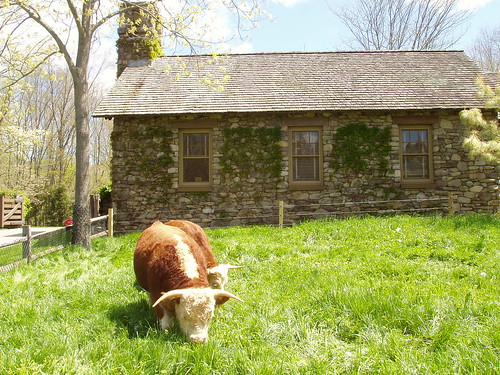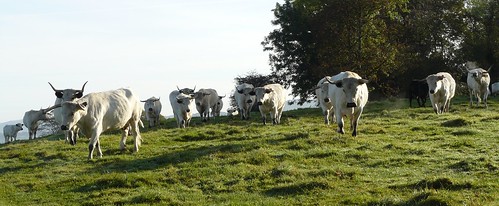The cattle breeds from the past will be the breeds preferred tomorrow. The three cattle breeds featured in this thread, are breeds which I have admired over time for the following reasons:
- Miniature cattle are practical and efficient and perfect for the rapidly growing number of smaller farms.
- I have eaten Piedmontese meat and have been absolutely amazed with the tender quality of this grass-fed beef.
- When I visited Seed Savers Exchange in Decorah, Iowa I learned about the ancient White Park Cattle breed and what they were doing to use and preserve these "feral" genetics.

flickr
Miniature cattle come in Hereford, Lowline Angus, Dexter, Zebu, and Jersey breeds. They are as charming as the above photo depicts. They are half to a third the size of a normal cow, but produce 50-75% of the rib-eyes and fillets. They are only 3-4 feet tall and weigh 500-700 pounds. One mini will feed a family of four for six months. Their genetics stem from breeds brought to America in the 1800's which weren't so large as today's giants. Minicow numbers quadrupled in this past decade in the U.S. to over 20,000. An acre of grass will support 1-2 minicows. They mature faster and are easier to handle than the larger breeds..
References:
Ten miniature cattle breeds for your small farm
VIDEO (3 Minutes)
Frequent Q & A about Mini Cows
Mini-Cows for Mini-Farms
Wikipedia
the Myostatin Beef Breed

This breed comes from the scenic Italian Alps Piemonte region. Piedmontese cattle originated from an ancient migration of cattle from Pakistan which interbred with the native Italian Aurochs. The breed is known for its consistent tenderness. They produce superior low cholesterol, low fat, high protein, low calorie beef.
The animal is light boned, has double muscling, long bodies, thinner hides, and smaller heads, minimizing waste. The term "double muscling" is a misnomer which means that dysfunctional myostatin removes a "growth governor", allowing these cattle to produce more muscle mass, but with low connective tissue between the muscle fibers making it extra-tender.

This breed produces 14% more meat, most all in the better cuts. These cattle are extremely heat, cold and insect tolerant, and feed efficient. They have excellent temperaments and are very tolerant mothers. Being slow to mature, they produce calves longer. Their rich milk has been used in Italy for specialty cheeses.
References:
VIDEO (1 minute)
good history here
Italian History
North American Piedmontese Cattle Association
Piedmontese Association of the United States
Piedmontese Society of NZ Inc

flickr
Right outside of Decorah, Iowa, a college, river-town nestled into the unique and idyllic driftless area, is the notable Seed Savers Exchange operation. This 35-year old non-profit is located on the 890-acre Heritage Farm. Besides preserving heirloom vegetable seeds, they harbor the ancient White Park Cattle breed. These cattle supposedly roamed the British Isles before the time of Christ. Park was added to their name when the isles were fenced. In their rich history, they have been used for milk and as plow-oxen. They came to North America when four cattle were moved to the Toronto zoo at the start of WWII for preservation.
They have feral qualities of intelligence, hardiness, healthiness, high fertility, easy calving, and are low maintenance grazers, preferring brush. These white cattle with black accents weigh 1400 (cows) to 2100 (bulls) pounds. They number about 1,200 world-wide.
Their purpose at Heritage Farm? One, preservation of this ancient bovinae's genetics which are at a great distance from other cattle breeds. Two, agrarian harmony through rotational grazing in the style of Joel Salatin. The grazing cattle are alternated with foraging pigs and chickens.
Leaping Waters, an organic farm in Virginia, likes this cattle breed because of its fascinating history and flavorful meat. They are well-suited to the farm's hilly pastures since they thrive on grass, weeds, and brush. This farm has provided White Park Cattle beef for serving at presidential inaugural events and to restaurants in New York City and Washington D.C.
References:
Saving The White Park Cattle (Decorah, Iowa)
B Bar Ranch Montana Grass Fed Beef
Leaping Waters Farm Alleghany Spring, Virginia
Wikipedia
RELATED:
This Feb/2010 TIME magazine article features a Dutch preservationist group whose goal is to restore aurochs to the European countryside since they were part of Europe's original ecosystem. Kerkdijk's inspiration came from his African travels, where giant herbivores are common. His group has already introduced English Exmoor ponies to the Netherlands' nature reserves. Similar wild horses and aurochs were side by side in European cave wall paintings.
Breeding Ancient Cattle Back from Extinction